Another busy week, this one featured a TransLink Mayor’s Council meeting, our third meeting of the term, but the first in-person meeting since inauguration. There was some good discussion, I thought I would share a bit. The first part of the meeting was a discussion of ridership returns, and how TransLink has adjusted the system through the slow recovery from COVID. There is good and news just OK news, but lots of reasons to be optimistic.
The just OK news is the headline that ridership is back up to 194 Million Annual journeys, which is about 82% of the pre-COVID peak, with bus journeys leading the comeback and West Coast Express lagging behind.

The good news is buried in the details. This recovery rate is by far the leader in North America, though we lag a bit behind most European systems. TransLink ridership in raw numbers is 5th highest of any metro region in North America, though we are the 24th largest service area by population. We have 60% more ridings than Seattle and Portland (our nearest cohorts in weather, demography, and size) combined. Metro Vancouver has more daily transit riders than the City of Chicago, which has three times our population.

Here in new west, our ridership recovery lags a bit behind the average at 77%, but we are still, at 28,000 journeys a day, one of the most transit-oriented neighbourhoods in the region.

A more interesting way to look at ridership is to put it in the context of the rapid ridership growth of the last decade. We are, essentially, back at 2014 ridership levels. In a sense, the current ridership levels harken back to the brief period post-olympics before we entered into that period of unsustainable crowding in the system. We are just starting to get to the point where crowding is starting to appear on some routes, tempered a bit by the noticeable change in travel patterns. Though we still have morning and afternoon “rush”, there is a lot more travel on weekends and offpeak times – reflecting reduced return-to-office ridership, and more service and recreational ridership.

One interesting aspect of this is the impact on monthly passes. Totally anecdotally (and indulging in my own bit of elite projection here) I hung up my compass wristband (which I used as a monthly pass) when COVID happened, and shifted to loading my compass card up and paying per ride. Clearly I was not alone here. This feeds into the discussion of revenue drivers for Translink, as farebox recovery has not been as fast as ridership recovery.
Which brings us to the financial situation. But I digress.
We then talked about the Ten Year Priorities for regional transportation. There has been much written about it, but this meeting Staff are seeking the Council’s endorsement of the plan which leans heavily on Rapid Bus (think 99 B-Lines in more locations) and BRT (which is something else entirely – but we will get deeper into that). They received it and endorsed it, unanimously, which is no mean feat around the Mayor’s Council table. We call come from different political backgrounds, 21 communities with different needs and priorities, but on this we speak as a united voice.

Two points of discussion raised in this plan, first related to the funding, second to the very idea of BRT.
This plan is not funded. It is natural that we need a unified and clear plan before we can seek the funding to achieve it, but endorsing the plan is not the end of the journey, only a rest point. We have work at the Federal and Provincial level, and in our own backyards, to secure a clear and predictable funding model to make this plan come to life. I am confident we will do it, as this plan is fundamental not just to the transportation plans of the region, but to the transportation, livability, affordability, and climate plans of the Province and the Country. As PoCo Mayor and Mayors Council Chair Brad West put forward at the meeting, this plan is not a “nice to have”, it is as necessary to the functioning of our region as our water, sewer, and electrical utilities. And we need to remember that as we work through the details of a funding plan.
The other conversation we need to have is about Bus Rapid Transit (“BRT”). This is a form of rapid and reliable transit that is common in many jurisdictions, but pretty new in North America. It offers a functionality somewhere above a streetcar or B-line, not quite to the level of full grade-separated light rail, but in a sweet spot that fits our region very well, provides a lot of flexibility, and saves us a tonne of money over elevated rail.
The trade-off is that BRT can take space away from other traffic. Though way less intrusive than an elevated rail line, it still means either re-allocation of existing road space, or creation of new dedicated road space. It has the potential to be one of those new infrastructure directions that everyone wants near them, but not too near. It will be more apparent to drivers than a tunnel or overhead light rail line. There also needs to be careful interface planning between BRT routes and other road users, such as pedestrian crossings, bike lanes, and even areas where we want to see traffic calmed, like pedestrian-oriented commercial areas.
So we have some work to do, to educate the public about BRT, and to educate senior government about our need for consistent and reliable funding. The good news is that the plan is solid, and solidly supported by the leadership of the region.